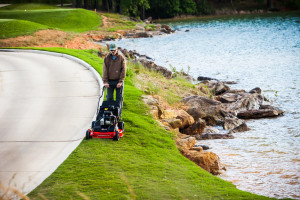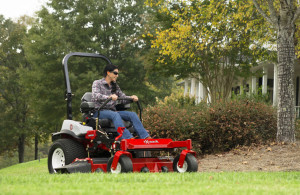If you own a property with steep hills, you know the challenges mowing and lawn care present. And when you add in walls, planters and other landscaping, and kids’ equipment such as trampolines, all of the sudden, mowing becomes akin to navigating an obstacle course. Which mower you choose for hills is an important factor in mowing your lawn safely and sustainably over time. In addition, taking the time to learn about all of the important safety features on your machine and how to safely navigate your mower on slopes and around obstacles is critical in helping prevent accidents.
Choose the Right Mower for Hilly Terrain
Exmark Lazer Z zero-turn riding mowers are the #1 choice of landscape professionals because of their unmatched ability to quickly and safely maintain a wide variety of properties. That said, zero-turn riding mowers should not be used on slopes of greater than 15 degrees, or a 26.8 percent grade. (Learn more about calculating slope and grade at EngineeringToolbox.com.) Maintain hills or surfaces with slopes of more than 15 degrees with a walk-behind mower or hand trimmer.

A walk-behind mower is a better choice than any riding mower for cutting grass near drop-offs or retaining walls, or at the edge of ponds.
While it may be tempting to mow close to the edge of water or retaining walls with your zero-turn mower, doing so can result in significant injury or death if the machine were to roll over. It’s better to keep a safe distance from these hazards, and come back with a walk-behind mower to trim near the edge.
Please take a moment to watch these “Driving in the Safety Zone” videos, which Exmark produced to help you identify safety hazards and how to safely operate your Lazer Z in hilly or uneven terrain, or around walls, water and other lawn hazards:
Exmark Lazer Z Introduction and General Safety
Exmark Lazer Z Safe Mowing of Slopes and Rollover Protection
Exmark Lazer Z Controls and Operation:
View more safety and operator training videos on the Exmark YouTube channel.
Other Considerations
- Use Protection: the rollover protection system (ROPS) on commercial mowing equipment should always be deployed in the full upright position during operation — along with the lap belt securely fastened low and tight around the operator’s waist. Failure to do either of these steps increases the risk of injury or death to the operator in a rollover situation.
-

Always deploy the rollover protection system (ROPS) in the full-up position during operation (as shown). Never operate the mower with the ROPS down or partially-deployed.
Moisture: avoid mowing hilly terrain when grass is wet from rain or dew. Not only is mowing wet grass sub-optimal for the turf itself, the reduced traction on wet grass increases the chances of your mower sliding on uneven terrain. Instead, wait until later in the day when the sun has burned the moisture off.
- Unstable ground: survey the property and identify any ponds, drop-offs (pay particular attention to fence lines) and retaining walls to ensure the stability of the ground being mowed.
By taking a little time to understand the slope and terrain of your property, you can choose the right mower to maintain every inch of your lawn safely.
Learn more about safe mowing at Exmark.com.






